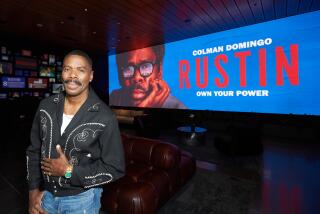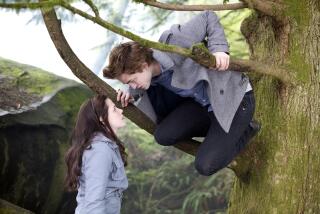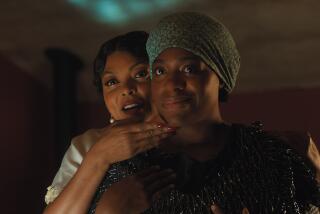The Envelope: Movies about LGBT characters yearn for happily ever after
There aren’t many happy endings in LGBT films. For decades, the through line on many filmed stories about lesbian, gay, bisexual and transgender individuals focused on a voyage of discovery that ended in disaster. Whether the tale was about identity, sexuality, acceptance or rejection, the ending was often predictable. And the message those stories conveyed? Bad endings always happen to “those” people. There’s no way out.
Which makes 2015 a particularly interesting year on a couple of levels. Not only are there multiple films that feature LGBT characters and story lines, they’re generally not being framed as tragedies. The struggle for personal and exterior acceptance is still there in such current movies as “Freeheld,” “Carol,” “Tangerine” and “The Danish Girl” (along with “About Ray,” the story of a transitioning teenager that will likely hit theaters next year) … but there’s an actual light at the end of most of their tunnels now.
SIGN UP for the free Indie Focus movies newsletter >>
“The challenge in the past has been that oftentimes LGBT characters in films were the butt of jokes or brutalized and died,” says GLAAD President Sarah Kate Ellis. “We would have to really fight to make some of these stories less dismal because they were the only depictions that those struggling with their identity or sexual identity were seeing.”
Part of the surge in these films comes from the success the subject matter has had on TV recently; Amazon’s transgender comedy “Transparent” won two Golden Globes early this year, and its actors have been honored with Emmys. “The film business and television are always reactive to what people want to see, and if people come to these movies or watch these TV shows, then more get made and more people are encouraged to tell their stories with different points of view,” says “Freeheld” producer Stacey Sher.
Her film, which opened in October, is about the real-life struggle to have registered domestic partners receive pension benefits from their significant others. But for Sher, the focus was not on that dry (if significant) legislative detail, it was on the relationship between the real-life couple of Laurel Hester (played by Julianne Moore) and Stacie Leigh Andree (Ellen Page), who fought for and won their equality.
“The love story was always pretty important to us,” Sher says. “This [story] is about two people in love who wanted to have their piece of the American dream.”
“The Danish Girl,” opening Friday, also kept its focus on the love story between transitioning Einar Wegener / Lili Elbe (Eddie Redmayne) and her wife, Gerda Wegener (Alicia Vikander); Einar’s journey to becoming Lili is buoyed by her supportive significant other throughout the film. The movie may end on a down note, but there is an element of triumph in it.
“The script I read in 2008 was so exceptionally well written that I fell in love with making that version of the film,” says director Tom Hooper. “It’s very loyal to that first draft — some things have a habit of falling apart in your hands if you examine them too closely.”
Yet “Danish” was far from an easy film to get made; producer Gail Mutrux optioned the script by Lucinda Coxon 15 years ago. “It’s a long journey,” acknowledges Hooper. “It was seen as a difficult film to finance, to get made, to cast — and there were a lot of people around me who didn’t understand why I wanted to do it.”
Such was the challenge with making the recently released “Carol,” a love story set in 1952 about younger Therese (Rooney Mara), who falls for the older Carol (Cate Blanchett). But producer Elizabeth Karlsen has had decades of experience with getting LGBT films made — she was a co-producer on 1992’s “The Crying Game,” for one thing.
“[‘Crying Game’] was very difficult to produce, and we were told it was a reprehensible script and we shouldn’t make it,” Karlsen recalls. “With all groups that are marginalized, it takes a long time for those voices to come into the mainstream.”
As for that happy ending, “Carol” also wraps things on a positive note — not in a neat bow perhaps, but with hope for the future of a kind rarely seen in LGBT-focused films. “Typically, characters who transgressed were punished — and it’s only recently we’re seeing that’s not the case,” says Karlsen. “Not every life or love story has a happy ending, but it’s wonderful to have a film that at least presents the possibility.”
Yet despite these shifts in content and frequency, GLAAD’s Ellis is still only cautiously optimistic about LGBT stories on the big screen. “This isn’t a long-standing trend,” she says. “Next year [the number of films] could drop again — I hope it isn’t flavor of the month.”
She hopes that filmmakers will look to successful models on television for their cues. “It’s almost second nature to integrate LGBT characters into plotlines when you look at TV,” she says. “Most of the top-rated shows have an LGBT character that’s not necessarily tragic. It would be beneficial for Hollywood — especially the big studios — to look at that model. And we’re headed that way … but I don’t think we’re there yet.”
More to Read
From the Oscars to the Emmys.
Get the Envelope newsletter for exclusive awards season coverage, behind-the-scenes stories from the Envelope podcast and columnist Glenn Whipp’s must-read analysis.
You may occasionally receive promotional content from the Los Angeles Times.






